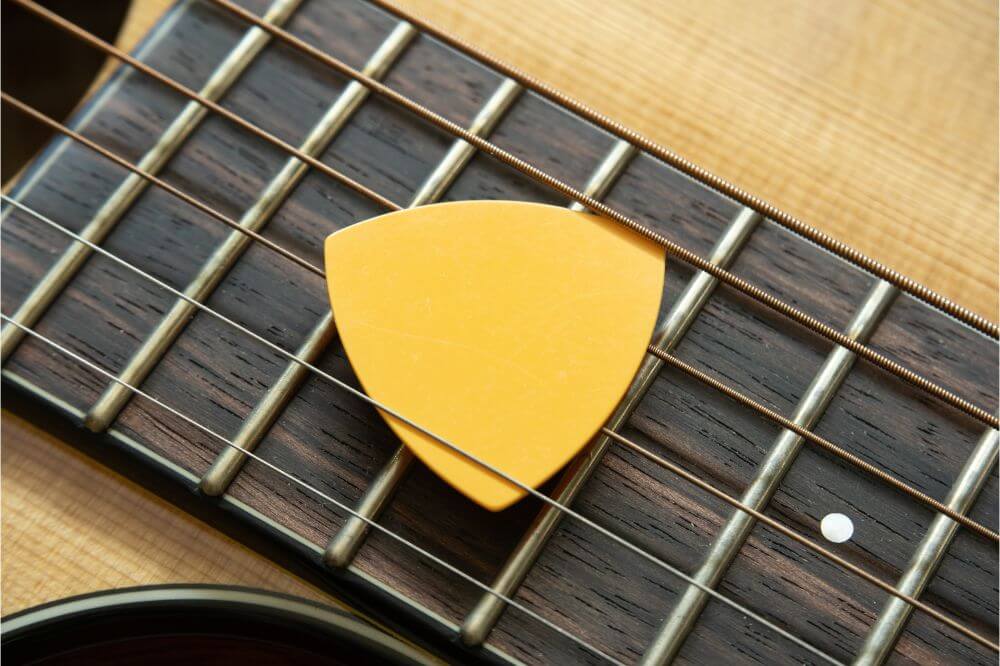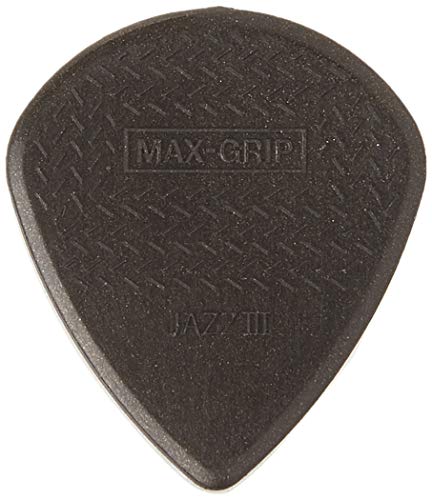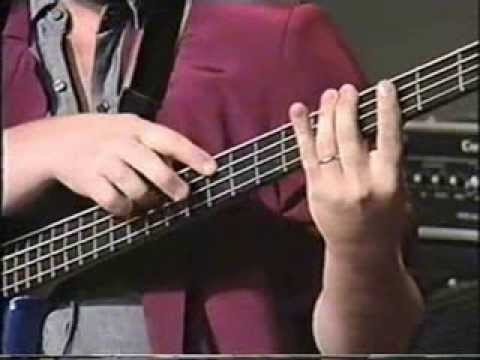Many people do not realize that guitar picks are not created equal. In fact, there are many different types of guitar picks made from various materials. The pick, or plectrum you are using will significantly affect the tone of your guitar, not to mention the feel of the music you are playing. For instance, some picks are ideal for playing an acoustic guitar, and some are not. Today, we will look at some of the best acoustic guitar picks and discuss pick weight, size, shape, and materials. Let’s get started.
What is the Best Type of Pick for an Acoustic Guitar?
The best picks are light to medium gauge for playing the acoustic guitar. They should be flexible enough to provide a balanced tone from your guitar.
Some of the best picks are those made with nylon or celluloid, as they are more flexible. However, if you will be playing lead guitar, you may want to choose a thicker pick that isn’t quite as flexible, made from acrylic or Delrin.
Grip, flexibility, and hardness are all important, and the material used to create the pick will play a significant role in all three factors. For instance, you will have some flexibility if you get a nylon pick, even a heavier gauge.
But on the other hand, no matter how thin an acrylic pick is, it will still be hard and not overly flexible.
Best Acoustic Guitar Picks: Reviews
We will review five of our favorite acoustic guitar picks and discuss what makes them so great.
Dunlop Max Grip Jazz III
The Dunlop Max Grip Jazz III is a small pick made from nylon. It has a grip and is ideal for those who need extra grip while playing. If you tend to drop your pick a lot, this may be the pick for you.
This is a step up from the original Dunlop Jazz guitar pick because of the grip surface. It may take you a bit of time to get used to using a pick with this much grip, but once you get used to it, you will come to love it.
Even if your fingers get sweaty while playing, you are not likely to drop this pick while you are playing.
Pros
- Flexible
- Comfortable to use
- No pick dropping
Cons
- May be uncomfortable until you get used to it
CHECK LATEST PRICE ON AMAZON.COM
Fender Premium Pick Sampler
This regular-size pick is made from celluloid and has no grip. It is available in various thicknesses – thin, medium, and heavy – so you can try them all out to get a feel for which thickness is best for your style of playing.
This is great for beginners learning how to use a pick. You can expect these picks to hold up because they are made from celluloid, even when playing a lot.
Pros
- Come in a variety of thicknesses
- Ideal for beginner acoustic guitar players
- Long-lasting
Cons
- Most of the picks in the pack are medium or hard. Not a lot of soft picks included
CHECK LATEST PRICE ON AMAZON.COM
Ernie Ball Everlast
This is a regular-size pick with a grip. It is made from Delrin and is ideal for playing the acoustic guitar in all styles. This is a low-cost set of 12 picks, so you will always have one available when you need it.
This is a reliable pick with a good grip surface that will prevent you from dropping it while playing. You can use these picks for strumming and picking, ideal for beginners.
Pros
- Good grip
- Multi-pack
- Ideal for beginners
Cons
- Seem quite flexible for a medium pick
CHECK LATEST PRICE ON AMAZON.COM
Black Mountain Thumpicks
This pick comes in the standard thumb pick size and can be made from plastic or metal. It has no grip, but it is unnecessary since you don’t hold the pick with your thumb and index finger.
So, if you are going to be doing any fingerpicking, this may be the best choice for you. It is made in two parts and has a metal hinge. This pick can get an interesting sound, which can also be used for strumming.
Pros
- Great for fingerpicking
- You can’t drop the pick while playing
Cons
- Using a thumb pick takes a bit of getting used to
CHECK LATEST PRICE ON AMAZON.COM
Planet Waves Beatles Signature Picks
While these picks may seem kitschy, they are excellent and look fantastic. Any Beatles fan who plays the guitar should have at least one set of these picks.
Each pick has a different picture of the Beatles, and they are high-quality picks. They come in a collectible tin, so you always have a place to store them. These picks are made from celluloid, are medium gauge, and do not have a grip.
Pros
- Cool graphics
- High-quality picks
- Collectible tin
Cons
- Could have a better grip
CHECK LATEST PRICE ON AMAZON.COM
Buyer’s Guide
Now let’s look at the factors to consider when choosing the right pick for playing the acoustic guitar.
Pick Thicknesses
Let’s discuss pick thicknesses, ranging from extra thin to extra heavy. Lightweight picks will give you a brighter tone and are ideal for strumming.
When a pick is thinner and more flexible, there will be less friction when it hits the strings. Conversely, you will get a much deeper sound with a heavier pick because of more friction. Therefore, a pick used for the bass guitar is much thicker than one you would use for a regular acoustic guitar.
Thin and Extra-Thin Picks
If you are just starting out and strumming an acoustic guitar, the best choice of pick will range from .4 and .6mm in thickness.
A pick of this thickness will give you a bright sound, and it is relatively easy to use for strumming. Because it is a lighter gauge, it isn’t going to drag, and the flexibility will let you really hit those strings. Picks of this thickness are popular with many rhythm guitar players.
Medium Thickness Picks
For many guitar players, the go-to pick will be between .6 and .8mm. This is what is known as a medium gauge guitar pick. This thickness range is highly versatile, and you get a slightly deeper tone than you would with a light gauge pick, more in the mid-range, while still having plenty of flexibility.
Heavy and Extra-Heavy Picks
If you are looking for a pick that will allow you to play with accuracy and have more control, you will want to use a heavy or extra-heavy pick. If your strumming technique isn’t entirely where it should be, a pick of this thickness can often help.
Because it is less forgiving than the lighter gauge picks, you will hear your mistakes a lot better, which will help improve your playing skills. Thicker picks will also give you a much deeper tone, and you will hear more of the bass notes. Therefore, these picks are commonly used for bass guitar.
Pick Materials
For many years, most guitar picks were made from tortoiseshell, with much of this material coming from the Hawksbill sea turtle. These are attractive picks that are strong and lightweight. However, while tortoiseshell is perfect for guitar picks, it is not good for the turtles.
In fact, by 1973, the Hawksbill sea turtle was put on the critically endangered list. This meant that pick manufacturers would need to come up with other materials. This was when synthetic picks made an appearance.
Pick manufacturers started experimenting with various materials, including celluloid, Delrin, plastic acetal, acrylic, and nylon. There are also picks made from natural materials, including wood and bone. Other materials, while not common, are felt and steel. Let’s look at the most common materials used to create guitar picks.
Nylon
The first material is nylon, which is smooth and soft. Unfortunately, it can be a bit too smooth and soft, so in many cases, you will find nylon picks have a textured coating on the top half. This makes it easier to hold while you are playing.
You will get a warmer tone when using a nylon pick. This material is quite flexible, absorbing more energy when it hits the strings.
When it comes to playing the acoustic guitar, nylon picks are ideal because they give you a rich sound when strumming. If you are playing lead guitar, you can get nylon picks in the heavier gauges to have that firmness you need for accuracy.
Celluloid
These picks look a lot like the older, popular tortoiseshell picks. It is harder than nylon, but there is still a fair degree of flexibility in the lighter and medium gauge picks. Also, because this material is lighter and stiffer than nylon, the pick will produce a much brighter sound. The only drawback is that you may find you get more string noise than using a nylon pick.
Celluloid picks are harder to grip when playing, and this can be even worse if you have sweaty hands. Also, they aren’t as durable as nylon picks, so you will find yourself replacing them more often.
Acetal or Delrin
If you are looking for a highly durable and very low-friction pick, you may want to try picks made from acetal. This is a very durable plastic that is quite strong and will take a lot of wear and tear. Dunlop first developed this material in 1981, using the trademark name Delrin. The company was looking for an alternative to tortoiseshell, and they came close with this material.
Many beginners find that they like using picks made with this material. It tends to be a bit on the stiffer side, and it has a matte finish, which makes gripping the pick much easier. However, if you find that your picks bend while you are playing, try using picks made from Delrin because they will go back to their proper shape faster than other materials.
Tortex is another name for Delrin, but while it is pretty much the same material, it is a bit on the grippier side, so it is easier to hold onto. Dunlop Tortex picks are among the most popular with guitar players worldwide. They are inexpensive and durable and produce a crisp tone.
Lexan and Acrylic
Picks made from acrylic and Lexan have a translucent appearance, and they are hard and durable. However, they can be difficult to hang onto and slip out of your fingers while playing. But some are made with a textured grip or have grip holes, making them easier to hang onto.
Because these materials are harder, they will give you a brighter tone. Also, there will be much more responsiveness in the feel because the materials aren’t as absorbent as others.
Ultem
If you are looking for a stiffer pick, you may want one made from Ultem, even in a lighter gauge. This is a very strong plastic preferred by pickers, particularly those who play mandolin or banjo. This is one of the strongest materials for guitar picks, and it will give you a bright and clear tone, particularly when playing an acoustic guitar. Dunlop manufactures picks with Ultex, which is the company’s proprietary name for Ultem.
Carbon Fiber
If you are looking for a lightweight guitar pick, carbon fiber is an excellent material. It is very durable, and picks made with this material often have a textured grip, making it easier to hold while playing. These picks are usually costlier than those made from other materials because more goes into their production. But, they can give you varying tones, depending on your playing dynamics.
This is a stiffer material, so even the thinner picks will have more stiffness than other materials. It is a bit on the abrasive side, but this will wear off over time as you use them. They can leave a bit of black residue on the fingers, but it washes off easily.
Size Matters
Many factors will come into play when choosing the right size pick. These include, but are not limited to, your comfort level when gripping a pick, and the amount of surface area of the pick you want to touch the strings.
A smaller pick is ideal for playing lead, since you need more control. But, there is a downfall here, and that is the pick is very small, so you have to grip it harder. After a while, you may notice your hand beginning to cramp up. Then again, if you are going to be combining picking and strumming, a smaller pick may be your better option.
When it comes to playing the acoustic guitar, a larger pick is optimal, especially if you will be doing a lot of strumming.
Larger picks will give you more variations in tone because the strings will be exposed to more of the pick’s surface area. Larger picks are also easier to grip, making them ideal for strumming. If you struggle with using a pick, it may be a good idea to move up to a larger pick that is easier to control.
Best Pick Shape
You’ve probably seen picks in various shapes, such as the traditional flat pick with rounded edges or the tri-tip pick, which has a rounded tip. The latter of the two will produce a much warmer sound than the flat pick, and it is ideal for playing an acoustic guitar. However, if you are looking at accuracy for lead work, it may be best to choose a sharper tip pick. This is also going to produce a brighter tone.
Another consideration is the bevel on the edge of the pick. The amount of bevel tends to vary. It all depends on how thick it is. For instance, there isn’t much beveling on a lighter pick.
Beveled picks aren’t ideal for strumming, so if you are playing an acoustic guitar, you may want to avoid them unless you are playing fast. In that case, you would want a beveled edge because it will prevent the pick from gripping onto the strings.
Thumb Picks
Then, there is the thumb pick. This is a pick worn on the thumb, so you don’t have to worry about gripping it. This can help to keep your hand from getting cramped up. In addition, you won’t have to hold it loosely, so there is no worry that it will slip out of your hand.
The thumb pick wraps around the thumb and allows your index finger to be free for picking. These picks are great for playing an acoustic guitar, especially if you will be doing any fingerstyle playing.
For instance, if you enjoy the unique sound of Travis picking, a thumb pick will help you achieve that sound. With this playing style, your hand will rest on the bridge. So, this type of pick will ensure that your tone is more focused, even though you are dampening the strings with the picking hand.
FAQ
Now let’s look at some of the most frequently asked questions about guitar picks.
Do I Always Need a Pick?
Whether or not you use a pick is up to you. In most cases, if you are going to be strumming an acoustic guitar, you will need a pick to produce the tone you are looking for. If you are fingerpicking, you may want to use finger and thumb picks.
Should I Get a Pick With a Grip?
If you find that you drop your picks a lot, or if your hands get sweaty and your pick slips, try using a pick with a grip. These are also referred to as cat tongue picks.
What Size Pick Should I Use?
The size of the pick you use will depend on what you are trying to achieve. For example, if you are picking, you will want a harder pick that will give you more control. On the other hand, a light or medium pick is the better option if strumming.
Conclusion
It will likely take a bit of trial and error to find the right guitar pick for you. We recommend trying out various picks so you can get a feel for each of them.
Once you get the hang of using a pick, you will have a pretty good idea about which pick will be best for your particular guitar-playing needs. Luckily, they aren’t overly expensive, so you can experiment with a variety until you find the one you like best.

























